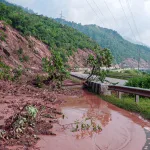J&K UT and Kashmir valley in particular is witnessing unprecedented climate variabilities from the last few years with above normal temperatures and erratic precipitation patterns. Being an ecologically fragile zone with limited adaptive capacity of farming systems, the impacts are obvious and we need to build appropriate policy frameworks, institutional capacity as well as mitigation and adaptation strategies. This is all the more important as these changing climate patterns cause shifts in crop suitabilities, disease and pest dynamics, decrease agricultural productivity and implicate human and animal health.
The current climate models predict a worst-case scenario of temperature increase of 5.2, 4.8 and 6.5 degrees Celsius in Kashmir, Jammu and Ladakh regions by the end of the 21st century. On a decadal scale, the maximum and minimum temperatures have increased by 0.27 and 0.19◦C respectively between 1980-2010. There has been deficit precipitation in last eight years, particularly 2023 and 2024 in winter period. Another alarming feature is that 95% of about 9500 glaciers in Himalayas are showing a receding trend. Across the globe, the number of hot days is progressively increasing whereas number of cold days is decreasing.
Agriculture is a major victim of climate variability as the plant growth, development as well as economic productivity of plants is significantly impacted by climate. In case of cereals, phenological shifts causing severe yield reductions due to changes in accumulation of heat units or growth degree daysand disease and pest incidences. Contrary to cereals, pulses undergo lesser impact as well as have lesser climate footprints, and will be a viable option in mitigation and adaptation to climate change. Moreover, they not only promote human and animal health, provide ecosystem services, but also contribute to farmers income as they invariably get 2-3 times more price compared to cereals. In fact, pulses will be key to our efforts to address the challenge of increasing farm productivity from less land, per drop of water, per unit input of fertilizers and pesticides, per unit of energy, and per unit of carbon emission.
Ecological benefits of pulses
- Pulses have a very low water footprint. Compared to around 3000-5000 litres/kg in cereals and 13000 litres/kg in beef, most legumes have water footprints of about 1000-1500 litres/kg.
- Among protein sources, pulses have the lowest full cycle CO2emission as low as 0.9 kg CO2/kg of produce.
- Improvement of physical, chemical and biological properties of soils, promoting ecosystem services through beneficial soil microbiome.
- Negative carbon footprints, as they sequester more CO2that they emit in full cycle, thereby acting as net sink of CO2.
Figure 1: Carbon footprints of protein sources
Agricultural benefits of pulses
- Increased grain yield due to pulses in rotation was greater in wheat than canola. Including pulses in crop rotations reduces the risks of soil erosion and depletion.
- Pulses improve the nitrogen economy of cereal cropping systems with fertiliser N-equivalent of 10-60 kg/ha.
- The cereal based cropping systems with legumes in rotation have upto 1.2 T/ha more equivalent yield increase, compared to cereal-cereal cropping systems.
- Residue of pulses has a lower C: N ratio (17) compared with 41 for oilseed and 32 for wheat that promotes mineralisation.
Climate adaptive benefits of pulses
- Pulses require less water with higher water use efficiency, have deeper root systems, and add nitrogen to soil thereby requiring lesser chemical fertilisers.
- Most pulses are short duration, and have better tolerance to drought and high temperature stress and can be grown in areas that have deficit rainfall.
- The net negative carbon footprints of pulses can help improve C-balance of cereal based cropping systems, by sequestering significant quantity of CO2.
- The soil carbon gain in pulses is higher than cereals even under dry conditions both in sole and intercrops with cereals. Cereal-cereal cropping systems have negative soil organic carbon (-0.006%) compared to legume-based systems where it is as high as (0.01%).
Promoting pulses in J&K Agriculture under changing climate
J&K UT and Kashmir valley is home to enormous diversity of pulses mainly Rajmash, Cowpea, Moongbean in summer season and Pea, Lentil, Chickpea, and Fababean in rabi season. There is huge scope for promoting pulses as climate smart crops especially under rainfed ecologies of Kashmir valley, as a substitute to rice and maize as well as a component of rice, wheat and maize based cropping systems. Especially in karewa lands as well as tail-end areas without assured irrigation, pulses could help boost farm productivity under sub-optimal climate scenario.
SKUAST-K has developed and released almost 20 high yielding varieties of Rajmash, Cowpea, Pea, Lentil, Moongbean and Chickpea, that can be grown by farmers as an alternative to cereal crops under deficit rainfall and high temperature conditions. There is a need to create awareness among farmers about climate adaptive potential of pulses, deploy high yielding varieties of pulses and develop appropriate production technology for various pulses and pulse-based farming systems. The long term effects of pulse based farming systems will include protection of soil, water and fossil resources, enhanced farmland biodiversity, lesser CO2 emissions, enhanced adaptive capacity to climate change, and healthy and sustainable food systems.
(Authors are Faculty at: SKUAST-Kashmir. Feedback: Email: [email protected])








